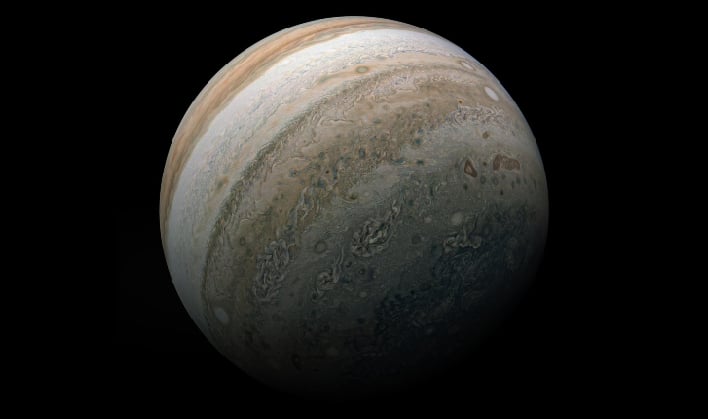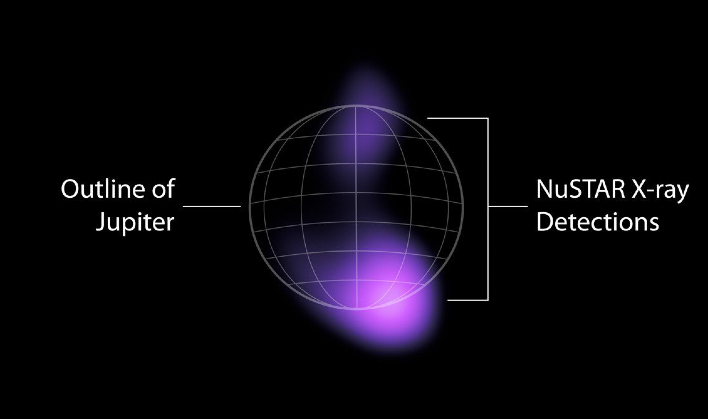NASA Telescope Solves 30-Year Mystery By Capturing Jupiter's Most Powerful Light Ever

Up close studies by scientists of Jupiter have been ongoing since the 1970's. And while there are still many mysteries yet to be uncovered with the gas giant, new observations by NASA's NuSTAR space observatory has revealed the answer to a decades long mystery. A new paper in the journal Nature Astronomy reports why the Ulysses mission was unable to see X-rays as it flew by Jupiter in 1992.
Light is emitted near the planet's north and south poles, as volcanoes on Jupiter's moon lo showers the planet with ions (atoms stripped of their electrons). The powerful magnetic field of Jupiter accelerates these particles, and then funnels them toward the planet's poles, at which point they collide with its atmosphere and release energy in the form of light. These low-energy X-rays from the gas giant's auroras have been observed and studied using NASA's Chandra X-ray Observatory and the European Space Agency's (ESA) XMM-Newton. X-rays are a form of light that is unable to be seen with the human eye.
"It's quite challenging for planets to generate X-rays in the range that NuSTAR detects," stated Kaya Mori, an astrophysicist at Columbia University and lead author of the recently published paper. "But Jupiter has an enormous magnetic field, and it's spinning very quickly. Those two characteristics mean that the planet's magnetosphere acts like a giant particle accelerator, and that's what makes these higher-energy emissions possible."
There were several obstacles that had to be overcome for researchers to make the NuSTAR detection. As an example, the higher-energy emissions are much fainter than the lower-energy ones. However, nothing seemed to explain why the Ulysses mission of 1992 was unable to observe them, being Ulysses was capable of detecting higher-energy X-rays than NuSTAR.

"If you did a simple extrapolation of the NuSTAR data, it would show you that Ulysses should have been able to detect X-rays at Jupiter," said Shifra Mandel, a Ph.D. student in astrophysics at Columbia University and co-author of the new study. "But we built a model that includes bremsstrahlung emission, and that model not only matches the NuSTAR observations, it shows us that at even higher energies, the X-rays would have been too faint for Ulysses to detect."
Researchers are also not done with their study of these emissions. William Dunn, a researcher at the University College London and a co-author of the paper explains, "The discovery of these emissions does not close the case: its opening a new chapter. We still have so many questions about these emissions and their sources. We know that rotating magnetic fields can accelerate particles, but we don't fully understand how they reach such high speeds at Jupiter. What fundamental processes naturally produce sugh energetic particles?"
NASA's NuSTAR space observatory revealed the highest-energy light ever detected from Jupiter, solving a 30 year old mystery. The Ulysses mission did not detect the high-energy light, as it flew by the planet back in 1992 and left researchers scratching their heads as to why.
Up close studies by scientists of Jupiter have been ongoing since the 1970's. And while there are still many mysteries yet to be uncovered with the gas giant, new observations by NASA's NuSTAR space observatory has revealed the answer to a decades long mystery. A new paper in the journal Nature Astronomy reports why the Ulysses mission was unable to see X-rays as it flew by Jupiter in 1992.
Light is emitted near the planet's north and south poles, as volcanoes on Jupiter's moon lo showers the planet with ions (atoms stripped of their electrons). The powerful magnetic field of Jupiter accelerates these particle, and then funnels them toward the planet's poles, at which point they collide with its atmosphere and release energy in the form of light. These low-energy X-rays from the gas giant's auroras have been observed and studied using NASA's Chandra X-ray Observatory and the European Space Agency's (ESA) XMM-Newton. X-rays are a form of light that is unable to be seen with the human eye.
"It's quite challenging for planets to generate X-rays in the range that NuSTAR detects," stated Kaya Mori, an astrophysicist at Columbia University and lead author of the recently published paper. "But Jupiter has an enormous magnetic field, and it's spinning very quickly. Those two characteristics mean that the planet's magnetosphere acts like a giant particle accelerator, and that's what makes these higher-energy emissions possible."
There were several obstacles that had to be overcome for researchers to make the NuSTAR detection. As an example, the higher-energy emissions are much fainter than the lower-energy ones. However, nothing seemed to explain why the Ulysses mission of 1992 was unable to observe them, being Ulysses was capable of detecting higher-energy X-rays than NuSTAR.
The answer was found in something called bremsstrahlung emission, which is German for "braking radiation". As fast-moving electrons encounter charged atoms in Jupiter's atmosphere, they are attracted to the atoms much like a magnet. The results are the electrons rapidly decelerating and losing engery in the form of high-energy X-rays. This can be compared to how a moving car transfers energy to its braking system to slow the vehicle down.
"If you did a simple extrapolation of the NuSTAR data, it would show you that Ulysses should have been able to detect X-rays at Jupiter," said Shifra Mandel, a Ph.D. student in astrophysics at Columbia University and co-author of the new study. "But we built a model that includes bremsstrahlung emission, and that model not only matches the NuSTAR observations, it shows us that at even higher energies, the X-rays would have been too faint for Ulysses to detect."
Researchers are also not done with their study of these emissions. William Dunn, a researcher at the University College London and a co-author of the paper explains, "The discovery of these emissions does not close the case: its opening a new chapter. We still have so many questions about these emissions and their sources. We know that rotating magnetic fields can accelerate particles, but we don't fully understand how they reach such high speeds at Jupiter. What fundamental processes naturally produce sugh energetic particles?"

